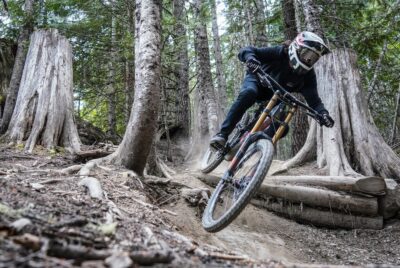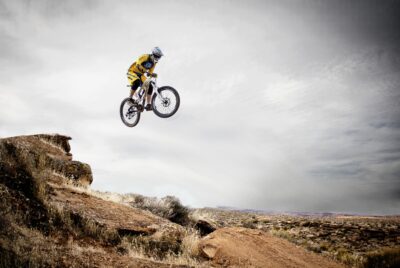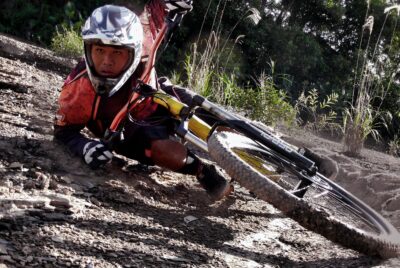Mountain Biking vs. Road Cycling: Key Differences
Introduction
As an avid cyclist, I have had the pleasure of exploring mountain biking vs road cycling. Each discipline offers a unique experience and caters to different preferences and goals. In this article, I will delve into the key differences between mountain biking and road cycling, providing insights and suggestions to help you choose the best option for your cycling adventures.
Terrain and Environment
When it comes to terrain and environment, mountain biking and road cycling couldn’t be more distinct. Mountain biking thrives in off-road environments, traversing challenging terrains such as dirt trails, rocky paths, and forested areas. On the other hand, road cycling takes place on paved roads, providing a smooth and consistent surface for speed and endurance.
Terrain Variations
Mountain biking allows you to immerse yourself in a diverse range of terrains. From steep climbs and thrilling descents to technical sections and obstacles, off-road trails present a thrilling and dynamic experience. The ever-changing terrain offers excitement and requires quick thinking and adaptability.
In contrast, road cycling primarily involves riding on asphalt or concrete roads. These routes are designed for efficient and uninterrupted travel, allowing road cyclists to focus on speed, endurance, and maintaining a steady rhythm. The absence of technical terrain on roads allows for consistent pacing and predictable riding conditions.
Natural Surroundings
One of the remarkable aspects of mountain biking is the opportunity to connect with nature. Riding through lush forests, scenic mountains, and picturesque landscapes immerses you in a serene and breathtaking environment. The sounds of chirping birds and the rustle of leaves create a tranquil ambiance that enhances the overall experience.
Road cycling, while lacking the natural surroundings of mountain biking, offers its own appeal. Riding on open roads allows you to appreciate the beauty of the countryside, picturesque vistas, and vibrant urban landscapes. The ability to cover long distances and explore new areas gives road cycling a sense of adventure and discovery.
Bikes and Equipment
Another significant difference between mountain biking and road cycling lies in the bikes and equipment used in each discipline. Let’s explore the distinctive features of mountain bikes and road bikes.
Mountain Bikes and Their Features
Mountain bikes are built to withstand rugged terrains and demanding trails. They feature sturdy frames, wide and knobby tires for better traction, and suspension systems to absorb shocks and impacts. The geometry of mountain bikes is designed to provide stability and maneuverability in technical terrain, with a more upright riding position for improved control.
Additionally, mountain bikes often come equipped with a wide range of gears to tackle steep ascents and facilitate smooth descents. The brakes on mountain bikes are powerful, allowing riders to navigate challenging terrain safely. These bikes are also equipped with wider handlebars for better control and specialized pedals to accommodate various riding styles.
Road Bikes and Their Features
Road bikes, also known as racing bikes, are designed for speed, efficiency, and endurance. They feature lightweight frames, narrow tires with minimal tread for reduced rolling resistance, and a more aggressive geometry for aerodynamics. The riding position on road bikes is more bent over, enabling cyclists to generate more power and maintain higher speeds.
Road bikes are geared towards fast-paced riding on smooth roads, prioritizing efficiency over shock absorption. As a result, road bikes usually lack suspension systems, keeping the bike lightweight and promoting energy transfer from the rider’s pedal strokes. Road bikes typically have drop handlebars for multiple hand positions and specialized pedals optimized for maximum power transfer.
Riding Techniques
Mastering the appropriate riding techniques is essential for both mountain biking and road cycling. Let’s delve into the key aspects of handling and control, as well as positioning and posture for each discipline.
Handling and Control
Mountain biking demands a strong focus on handling and control, given the technical nature of off-road trails. Negotiating obstacles, maneuvering tight turns, and maintaining balance on challenging terrain require specific skills. Mountain bikers learn to shift their body weight, use proper braking techniques, and make split-second decisions to navigate obstacles and maintain control.
On the other hand, road cycling emphasizes maintaining a steady rhythm and efficient riding technique. While handling and control are still important, road cyclists focus more on maintaining a consistent cadence, practicing smooth cornering, and drafting techniques for group rides. Road cycling techniques often revolve around maximizing speed and minimizing wind resistance.
Positioning and Posture
In mountain biking, body positioning plays a vital role in conquering various terrain features. When riding downhill, shifting weight backward and lowering the center of gravity enhances stability and control. Uphill sections require a forward position to maintain traction and efficiently transfer power to the pedals. Additionally, mountain bikers need to adapt their posture based on the trail conditions, such as crouching low for technical descents or extending the body for jumps.
Road cycling focuses on achieving an aerodynamic posture to optimize speed and efficiency. Cyclists aim to reduce wind resistance by tucking the elbows in, maintaining a flat back, and bending at the waist. This posture, along with proper pedal stroke mechanics, allows road cyclists to generate power and maintain a consistent cadence over long distances.
Fitness and Endurance
Both mountain biking and road cycling offer excellent opportunities for improving fitness and building endurance. Let’s examine the fitness aspects of each discipline.
Strength and Power
Mountain biking demands a combination of cardiovascular fitness and muscular strength. The physical challenges of navigating technical terrain, climbing steep inclines, and controlling the bike through rough sections require a robust lower body, core stability, and upper body strength for bike handling. The constant changes in terrain and the need to generate power for quick bursts of acceleration contribute to overall strength development.
Road cycling primarily focuses on cardiovascular fitness and endurance. Pedalling at a consistent cadence over long distances improves cardiovascular health, enhances lung capacity, and builds leg endurance. While road cycling does not require as much upper body strength as mountain biking, a strong core and stable posture are crucial for efficient power transfer and reducing fatigue.
Cardiovascular Demands
Mountain biking incorporates both aerobic and anaerobic elements. The intense bursts of climbing, sprinting, and navigating technical sections elevate the heart rate, providing a high-intensity cardiovascular workout. The varied terrain and unpredictable challenges keep the body constantly engaged, demanding quick energy production and recovery.
Road cycling is renowned for its cardiovascular benefits. Endurance rides, whether solo or in groups, provide a continuous aerobic workout that strengthens the heart, improves circulation, and enhances overall cardiovascular fitness. Sustained efforts at a moderate intensity for extended periods contribute to increased stamina and the ability to tackle long rides.
Risk Factors
Both mountain biking and road cycling come with their own set of risk factors and safety considerations. Let’s explore the potential hazards associated with each discipline.
Injury Risks and Safety Measures
Mountain biking, with its technical terrain and unpredictable obstacles, carries a higher risk of injury. The potential for falls, collisions, and impacts necessitates the use of protective gear such as helmets, knee pads, and elbow guards. Proper bike maintenance, including regular checks on brakes and suspension, is essential for optimal safety. Additionally, acquiring skills and gradually progressing in difficulty level can help minimize the risk of injuries.
Road cycling involves sharing the road with vehicles, which introduces its own safety concerns. Cyclists must follow traffic rules, signal their intentions, and wear highly visible clothing to ensure they are seen by drivers. Wearing a well-fitted helmet is crucial for head protection in the event of accidents. Familiarity with road cycling etiquette, such as riding in single file, maintaining proper spacing, and being aware of traffic conditions, is vital for a safe riding experience.
Traffic and Road Hazards
Road cyclists face the challenge of sharing the road with motor vehicles. Traffic conditions, including busy intersections, blind spots, and distracted drivers, pose potential risks. Cyclists must remain vigilant, anticipate traffic movements, and communicate their intentions clearly. Road hazards such as potholes, debris, and uneven surfaces require attentiveness and quick reactions to avoid accidents.
Mountain biking, while predominantly off-road, still has its own set of hazards. Trail conditions can change rapidly, with obstacles like rocks, roots, fallen branches, and loose surfaces. Mountain bikers must scan the trail ahead, choose appropriate lines, and react quickly to navigate challenging sections. It’s crucial to be mindful of potential hazards and adjust riding techniques accordingly.
Community and Culture
The community and culture surrounding mountain biking and road cycling contribute to the overall experience of each discipline.
Group Riding Dynamics
Mountain biking offers opportunities for group rides, fostering a sense of camaraderie and shared experiences. Riding with fellow mountain bikers allows for mutual support, skill sharing, and the chance to explore new trails together. Group rides can range from casual outings to more competitive events, catering to riders of various skill levels and interests.
Road cycling often revolves around group rides as well, providing a social aspect to the sport. Riding in pelotons allows cyclists to draft off one another, conserve energy, and push their limits. Group dynamics, teamwork, and communication play crucial roles in road cycling, where riders often work together to maintain pace, rotate positions, and navigate complex routes.
Events and Competitions
Both mountain biking and road cycling offer a wide range of events and competitions for enthusiasts to participate in. Mountain bike races encompass various formats, including cross-country, downhill, enduro, and marathon races. These events showcase technical skills, speed, and endurance, and they attract riders from different backgrounds and age groups. Mountain biking events often embrace a laid-back and adventurous atmosphere, celebrating the spirit of exploration and challenge.
Road cycling features a rich calendar of races, including professional races, sportives, and charity rides. From local criterium races to multi-stage grand tours, road cycling events showcase high-speed racing, strategic team dynamics, and individual prowess. Road cycling events tend to draw large crowds of spectators, creating a festive and competitive ambiance.
Conclusion
In the end, choosing between mountain biking and road cycling boils down to personal preference and goals. Mountain biking offers adrenaline-fueled adventures in natural surroundings, technical challenges, and a sense of exploration. Road cycling focuses on speed, endurance, and covering long distances on smooth roads, with a more competitive and community-oriented atmosphere.
Consider your affinity for nature, your preferred type of terrain, your fitness goals, and your appetite for risk when making your decision. Many cyclists enjoy both disciplines and find pleasure in alternating between mountain biking and road cycling based on their mood and objectives.
FAQs
1. Can I use a mountain bike on the road?
While possible, mountain bikes are not optimized for road riding. Their design and features are better suited for off-road terrain, and road biking on a mountain bike may be less efficient and slower compared to using a road bike.
2. Is mountain biking more physically demanding than road cycling?
Mountain biking generally requires more physical exertion due to the technical nature of the terrain, constant changes in elevation, and the need for quick bursts of power. Road cycling focuses more on endurance and maintaining a steady pace over longer distances.
3. What safety precautions should I take while mountain biking?
It is crucial to wear appropriate protective gear, including a helmet, knee pads, and elbow guards. Familiarize yourself with trail difficulty ratings and gradually progress to more challenging trails. Regularly maintain your bike and be aware of potential hazards on the trail.
4. Can I switch between mountain biking and road cycling?
Yes, many cyclists enjoy both disciplines and switch between them based on their preferences and goals. Each discipline offers a unique experience and benefits, allowing riders to diversify their cycling adventures.
5. How can I choose between mountain biking and road cycling?
Consider factors such as your affinity for nature, preferred terrain, fitness goals, and appetite for risk. Test both disciplines if possible and evaluate which aligns better with your interests and provides the experience you seek.




